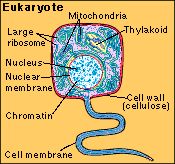The reconstruction of phylogeny - How do we analyze the characters used in phylogenetic inference?

Ancestral and derived homologies
Once homologies rather than homoplasies have been identified, the next stage is to divide the homologies into ancestral and derived homologies.
An ancestral homology was present in the common ancestor of the two species, but evolved earlier and is also shared with other, more distantly related species.
A derived homology first evolved in the common ancestor of the two species and is not shared with other more distantly related species.
If the two species were a human and a salmon, for example, the backbone is a derived homology; it first evolved in the common ancestor of the vertebrates - which is also the common ancestor of these two species. The presence of a distinct nucleus within all their cells is an ancestral homology; it was present in the common ancestor of the vertebrates, but evolved earlier, in the common ancestor of all eukaryotes (pictured opposite). Whether a homology is ancestral or derived therefore depends on the set of species being compared. The backbone is a shared derived homology in a human and a salmon; but it is a shared ancestral homology in a human and a chimp.
Only shared derived homologies are evidence that two species share a more recent common ancestor with each other than with any other species under investigation. Because all characters have evolved in the same phylogenetic tree, all the shared homologies must fall into the same pattern of groups. If, in a number of characters, the homologies and character polarities have been correctly identified, it is impossible for different shared derived characters to suggest incompatible phylogenies.
A set of species can no more have multiple phylogenetic relations than a human family can have more than one family tree. If a human family has two family trees in its possession, one of them must be wrong; likewise, if two characters suggest incompatible phylogenies, the analysis for one of them must be wrong. The same is not true for analogies and ancestral homologies: both can fall into conflicting groups of species. Ten different analogies, or ten different ancestral homologies, can fall into up to 10 different, and conflicting, groupings of species.
Figure: all plants and animals have eukaryotic cells which have a separate nucleus containing DNA. Since it was present in the common ancestor of all eukaryotes it is an ancestral homology and of no value for inferring phylogeny among plants and animals.
| Next |



